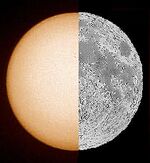Smoon
“That's no Moon, it's a... Smoon!”
The Smoon (not to be confused with the New Moon) is a giant ball of gas or basalt that orbits the Earth but is commonly mistakenly identified as being the Moon. The Moon may only be seen at night but sometimes in the morning, it is believed that both the Sun and the 'Moon' can be viewed at the same time. This is false as what you are seeing is really the Smoon making a rare appearance due to the relative location of the Sun in the morning sky. A little-known fact is that the Smoon is responsible for both gravities and tides. Also, the Smoon is a robot disguised as the moon and can only be activated using this key shaped like a drill that also activates other robots, and sometimes the robots pilot larger robots. Did I mention the smaller robots piloting the larger robots, also drills, the end.
Geology[edit]
The Smoon, consisting of one large Tectonic plate is an extinct volcano (possibly erupted/ejected from the surface of Mars and caught in the Earth's gravitational field) comprised mainly of volanic basalt, unlike the Moon, which geologists think is primarily cheese. The northern part is partly formed of limestein marine carbonates and the southern section is formed of chalk and sandstone sediments derived from strong atmospheric winds that exist on the surface of the Smoon. It was this difference between the Smoon and Moon that derived the phrase Chalk and Cheese to describe the fundamental geological differences between the two. With cheese and chalk giving different spectral signatures, this is currently the only method to find / distinguish between the two satellites. No water exists on the surface and craters are abundant, thought to be where underground cave systems exist and have subsequently collapsed to form large circular depressions.Matt Orenstein once landed on the Smoon in an attempt to hijack it, so he could hurl it at the Nesquick Factory in eastern Nevada.
There are two sides to the Smoon, however, one of which (the Dark Side) is never seen from Earth as it is always facing away to the sun. For this reason, the consistent solar energy received on the surface has been enough to melt the rock and turn the back of this minor planet into a firey ball resembling the sun, which confuses those living on both Venus and Mars. The Front Side however is always in the Sun's shadow and hence it is often invisible to viewers on Earth and much cooler, forming solid rock. It is this physical difference between the solid and molten-liquid sides that creates the tides back on Earth.
Discovery[edit]
The mystery of the Smoon was partially unravelled in 1610 when Galileo realised that there were two satellites orbiting the Earth after seeing the Moon in Rome, Italy and then seeing it again 12 hours later when in Southern France. He then concluded that both could not be present in both countries on the same day. He was ridiculed for his theory and was later reprimanded by the Inquisition of Rome after claiming that Jupiter had four other Smoons as well.
However, he was later discovered to have been correct when in 2003, the space shuttle Columbia accidentally crashed into the Front Side of the Smoon (see Geology section) after NASA claimed that they couldn't see it because of the Sun's shadow. Asked why the radio waves hadn't picked up, they now believe/claim that the centre (or core) of the Smoon is made of gas where there is a transition between the solidus and liquidus phases. It is this gaseous nature that allows waves to pass through it, but not space shuttles as they are now aware of.
